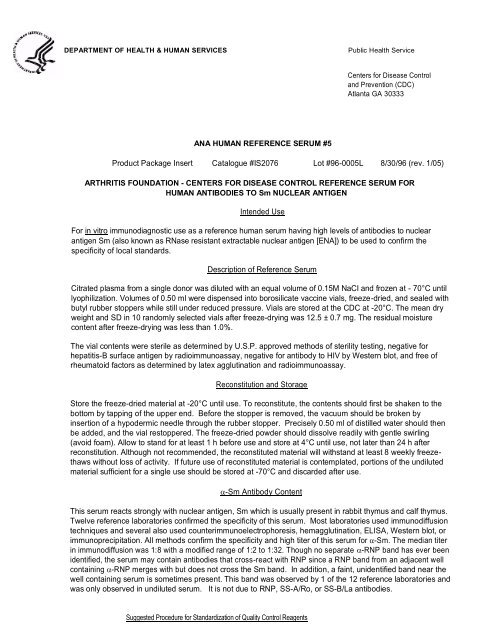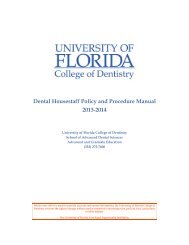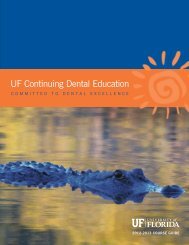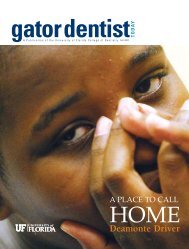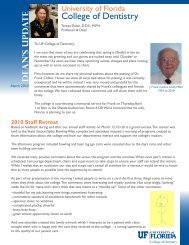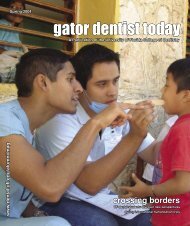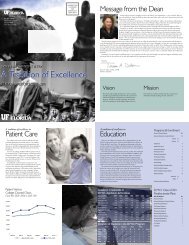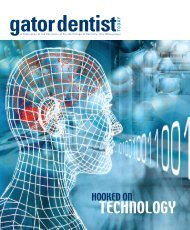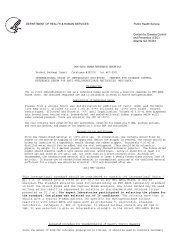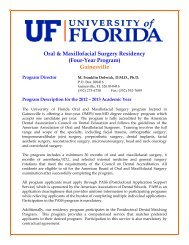anti-Sm
anti-Sm
anti-Sm
You also want an ePaper? Increase the reach of your titles
YUMPU automatically turns print PDFs into web optimized ePapers that Google loves.
DEPARTMENT OF HEALTH & HUMAN SERVICES<br />
Public Health Service<br />
Centers for Disease Control<br />
and Prevention (CDC)<br />
Atlanta GA 30333<br />
ANA HUMAN REFERENCE SERUM #5<br />
Product Package Insert Catalogue #IS2076 Lot #96-0005L 8/30/96 (rev. 1/05)<br />
ARTHRITIS FOUNDATION - CENTERS FOR DISEASE CONTROL REFERENCE SERUM FOR<br />
HUMAN ANTIBODIES TO <strong>Sm</strong> NUCLEAR ANTIGEN<br />
Intended Use<br />
For in vitro immunodiagnostic use as a reference human serum having high levels of <strong>anti</strong>bodies to nuclear<br />
<strong>anti</strong>gen <strong>Sm</strong> (also known as RNase resistant extractable nuclear <strong>anti</strong>gen [ENA]) to be used to confirm the<br />
specificity of local standards.<br />
Description of Reference Serum<br />
Citrated plasma from a single donor was diluted with an equal volume of 0.15M NaCI and frozen at - 70°C until<br />
lyophilization. Volumes of 0.50 ml were dispensed into borosilicate vaccine vials, freeze-dried, and sealed with<br />
butyl rubber stoppers while still under reduced pressure. Vials are stored at the CDC at -20°C. The mean dry<br />
weight and SD in 10 randomly selected vials after freeze-drying was 12.5 ± 0.7 mg. The residual moisture<br />
content after freeze-drying was less than 1.0%.<br />
The vial contents were sterile as determined by U.S.P. approved methods of sterility testing, negative for<br />
hepatitis-B surface <strong>anti</strong>gen by radioimmunoassay, negative for <strong>anti</strong>body to HIV by Western blot, and free of<br />
rheumatoid factors as determined by latex agglutination and radioimmunoassay.<br />
Reconstitution and Storage<br />
Store the freeze-dried material at -20°C until use. To reconstitute, the contents should first be shaken to the<br />
bottom by tapping of the upper end. Before the stopper is removed, the vacuum should be broken by<br />
insertion of a hypodermic needle through the rubber stopper. Precisely 0.50 ml of distilled water should then<br />
be added, and the vial restoppered. The freeze-dried powder should dissolve readily with gentle swirling<br />
(avoid foam). Allow to stand for at least 1 h before use and store at 4°C until use, not later than 24 h after<br />
reconstitution. Although not recommended, the reconstituted material will withstand at least 8 weekly freezethaws<br />
without loss of activity. If future use of reconstituted material is contemplated, portions of the undiluted<br />
material sufficient for a single use should be stored at -70°C and discarded after use.<br />
-<strong>Sm</strong> Antibody Content<br />
This serum reacts strongly with nuclear <strong>anti</strong>gen, <strong>Sm</strong> which is usually present in rabbit thymus and calf thymus.<br />
Twelve reference laboratories confirmed the specificity of this serum. Most laboratories used immunodiffusion<br />
techniques and several also used counterimmunoelectrophoresis, hemagglutination, ELISA, Western blot, or<br />
immunoprecipitation. All methods confirm the specificity and high titer of this serum for -<strong>Sm</strong>. The median titer<br />
in immunodiffusion was 1:8 with a modified range of 1:2 to 1:32. Though no separate -RNP band has ever been<br />
identified, the serum may contain <strong>anti</strong>bodies that cross-react with RNP since a RNP band from an adjacent well<br />
containing -RNP merges with but does not cross the <strong>Sm</strong> band. In addition, a faint, unidentified band near the<br />
well containing serum is sometimes present. This band was observed by 1 of the 12 reference laboratories and<br />
was only observed in undiluted serum. It is not due to RNP, SS-A/Ro, or SS-B/La <strong>anti</strong>bodies.<br />
Suggested Procedure for Standardization of Quality Control Reagents
Since the amount of AF/CDC reference preparation is limited, it should be used to calibrate secondary standards which can be run each day along with<br />
other samples being analyzed. The validity of any secondary standard depends on its having the same specificity as the primary AF/CDC standard<br />
(<strong>anti</strong>-nDNA, <strong>anti</strong>-<strong>Sm</strong>, etc.). The specificity can be determined by EIA, Western blot, double immunodiffusion (<strong>anti</strong>-nRNP, <strong>anti</strong>-<strong>Sm</strong>, <strong>anti</strong>-SSB/La) or by<br />
analysis for <strong>anti</strong>-nDNA (Farr assay, millipore filter assay, Crithidia test).<br />
To confirm the specificity of a secondary standard in double diffusion or counterimmuno-electrophoresis:<br />
1. Reconstitute the ampule as described above.<br />
2. Use both undiluted (neat) and 1:4 dilutions of the AF-CDC sera and the secondary standard.<br />
3. Arrange <strong>anti</strong>body wells such that the secondary standards (neat and 1:4) are each next to an undiluted and 1:4 dilution of the AF-CDC<br />
serum.<br />
4. Run the routine test procedure using nuclear extract <strong>anti</strong>gen.<br />
5. Lines of identity should be obtained without extra lines or ambiguous reactions.<br />
To calibrate a secondary standard (double diffusion, counterimmunoelectrophoresis):<br />
1. Reconstitute the ampule as described above.<br />
2. Prepare undiluted and serial four-fold dilutions up to 1:256 of the secondary standard and AF-CDC serum.<br />
3. Run the routine test on all dilutions.<br />
4. Relative potency = reciprocal of end point dilution of secondary standard<br />
reciprocal of end point dilution of AF-CDC serum<br />
If the secondary standard is stable, the relative potency obtained should not change when periodically recalibrated. Any changes in day to day results<br />
with the secondary standard are more likely due to changes in test performance. Titer results may be particularly useful in assessing lot to lot changes<br />
in <strong>anti</strong>gen preparations and for comparison of your results with the laboratories which initially evaluated these sera (see <strong>anti</strong>body content above).<br />
Caution<br />
This serum was found to be negative for hepatitis-B surface <strong>anti</strong>gen, hepatitis C and HIV <strong>anti</strong>body. Since no test method can offer complete assurance<br />
that these or other infectious agents are absent, this serum should be handled at the Biosafety Level 2 as recommended for any potentially infectious<br />
human serum or blood specimen (Centers for Disease Control, National Institutes of Health. Biosafety in Microbiological and Biomedical Laboratories,<br />
1 st Edition, 1984, 11-13.}<br />
Supplementary Information<br />
The references for a general description of the AF-CDC reference sera are: Tan EM, et al. Reference Sera for Antinuclear Antibodies I. Arthritis<br />
Rheum 25:1003-1005,1982. <strong>Sm</strong>olen JS et al. Reference Sera for Antinuclear Antibodies II. Arthritis Rheum 40: 413-418,1997. Detailed descriptions of<br />
the preparation, analysis, reagents, <strong>anti</strong>gens, substrates, and individual reference laboratory results are in a supplementary publication available upon<br />
request:<br />
AF-CDC ANA Reference Lab<br />
Immunology Branch, 17-3040, A25<br />
Centers for Disease Control and Prevention (CDC)<br />
Atlanta, GA 30333


